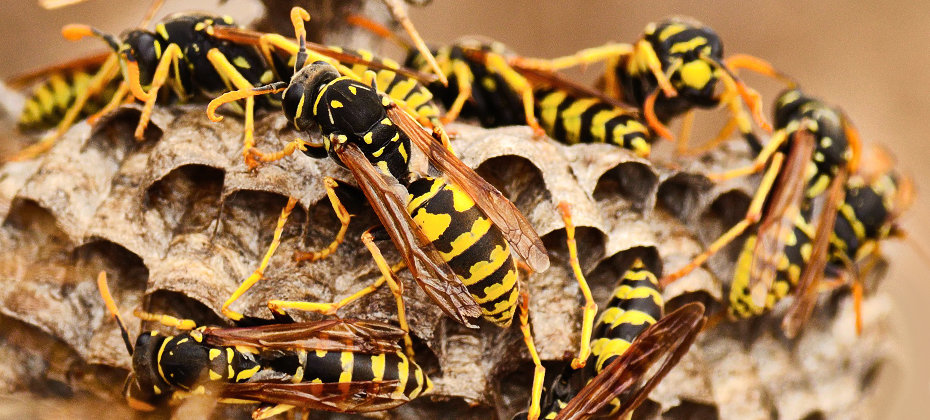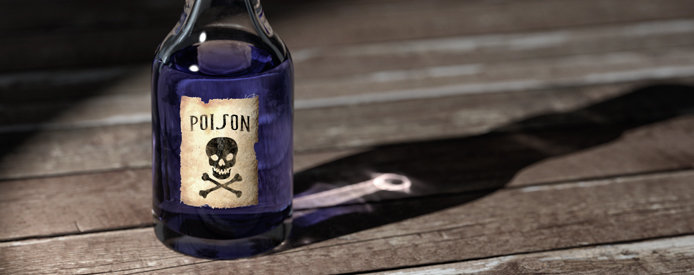

Wasps and hornets pollinate plants and flowers and catch insects to feed their young. Although both functions are beneficial, aggressive wasps that have built a nest on or near your house often need to be exterminated. For that job, you'll need some effective wasp and hornet killer spray.
But you'll need to know these important safety tips before you pick up a can of wasp spray and start wantonly firing a stream into the air like you're Harold Ramis in Ghostbusters. The dangers of wasp spray to humans are all too real, and you’ll want to take steps to protect yourself, your family, and your pets.
What are the Most Effective Hornet and Wasp Sprays?
There you are at the store, ready to pick up some wasp and hornet spray, and quickly you experience choice paralysis! There are so many wasp killer sprays to choose from, but which is the best (and safest) choice?
There are many effective wasp spray options. When spraying wasps, you’ll want to keep your distance and avoid getting any spray on you (most effective wasp and hornet sprays are also quite toxic). Here are the best options to help you narrow down the selection.
Terro Wasp & Hornet Killer
- Good spray distance, spraying up to 20 feet.
- Kills wasps, hornets, and yellow jackets.
- Extremely thick foam coats the nests.
- Cap for added safety.
Prevents wasps from returning for up to 4 weeks.
Ortho Home Defense Foaming Aerosol Spray Wasp & Hornet Killer
- Formulated to kill wasps, hornets, yellow jackets, and mud daubers.
- Foam kills insects immediately.
- Kills insects that return to the wasp nest.
- Jet spray up to 20 feet above the ground.
Raid Liquid Aerosol Spray Wasp & Hornet Killer
- Aerosol spray reaches up to 22 feet.
- Kills hornets, wasps, and yellow jackets.
- Kills on contact and when wasps return to the nest.
- Kills larvae and pupae.
- Electronically non-conductive and safe up to 32,500 volts.
Spectracide Liquid Aerosol Spray Wasp & Hornet Killer
- Spray can reach up to 27 feet.
- Water-based and non-staining.
- Kills on contact.
- Kills the entire nest.
- Quick spray formula made for fast knockdown and kill.
The Best Time to Spray Wasp and Hornet Nests

Don’t sleep in! If you need to spray wasps, it's best to carefully choose the right time of day. Because of the danger of being swarmed and stung multiple times, you should not engage wasps or hornets when they are active. So, when is the best time to spray a wasp's nest? Wait to spray hornets and wasps until the early morning or after dark—the times when they are largely motionless.
How to Spray Wasps and Hornets Nests
Once you've chosen your spray, it's essential to know how to find the nests and determine where all the wasps and hornets are hiding and living. This might mean playing a game of hide and seek to discover where the wasps live in your yard.

The wasps’ nest may not be immediately visible, so you may have to do some sleuthing. First, follow the wasps, hornets, or yellow jackets to see if they're all heading to the same place. If you don't see a wasps’ nest, see if you can find a loose edge or hole where the insects are coming in and out. Wasps often hide nests in out-of-the-way places for protection.
When you've determined that your location, direction, and distance are safe, spray the wasp and hornet spray on the nest until it is fully saturated. A wasp's nest is made of tough, paper-like wood fibers that have been formed into combs with many cells, so soak it well to ensure that you've gotten the wasp killer spray to every wasp, hornet, or yellow jacket inside.

How Long Does It Take for Wasp and Hornet Spray to Work?
Most wasp and hornet sprays are immediately effective for killing some wasps, hornets, or yellow jackets on contact, but it can take time for the spray to fully penetrate the nest and get rid of the larvae and pupae that are inside. In addition, wasps and hornets typically leave the nest to feed regularly, so some may need to return before the spray eliminates them.
It usually takes about 24 hours for wasp and hornet spray to work. After a 24-hour period, watch the nest carefully for several minutes. If no wasps or hornets are visible, use something to knock it down from a distance. If you see any insects flying, respray the nest and wait 24 more hours before knocking it down.
The Danger of Wasp and Hornet Spray to Humans and Animals

Is wasp spray dangerous for humans? What about pets? How can you safely use wasp and hornet spray?
The first tip when using wasp and hornet spray is to be extremely cautious! Wasp and hornet spray is POISONOUS. It can be highly toxic to people and animals, so take extra care when using it and always follow all the instructions outlined on the spray can.
If any wasp and hornet spray gets into your eyes or mouth, call Poison Control immediately at 800-222-1222. If there is an emergency, bring the can with you so medical personnel will know exactly what brand and type of wasp spray they're dealing with.

Although insecticides like wasp spray are formulated to be deadly to their target insects, they can also be toxic or poisonous to other creatures. Protect your pets by keeping dogs, cats, and other animals out of the area where you’re spraying. It's also important to note that wasp and hornet killer is especially toxic to fish and other aquatic animals, so don’t use wasp spray on or near water.
7 Tips for Using Wasp and Hornet Spray Safely
1. Don’t Use Wasp Spray Inside

Occasionally, winged enemies like wasps and hornets figure out how to get inside. How do wasps get inside your house? Usually, it's through a hole in a window screen or a door inadvertently left open. Your first instinct might be to grab the can of wasp killer spray and fire away, but DON'T do this! It isn’t safe to use wasp and hornet spray indoors! These insecticides are only for outdoor use (there are milder, safer types of spray for indoor insects). If a single wasp is inside the house, use a flyswatter (or any other available bludgeon you can find in your near-panicked state). There are also reusable wasps and yellowjacket traps that you can also set up near the entryways to your home. Call a professional exterminator if you discover a wasp or hornet nest inside your wall or attic.
2. Wear Protective Clothing

Protective clothing is essential when exterminating angry flying insects with venom and the ability to sting multiple times, particularly hornets, wasps, and yellow jackets. So how should you dress when spraying for wasps? Long sleeves, pants, and shoes that cover your entire foot are wise choices. A beekeeper's hat and veil are also a great option if you can access one.
3. Stand a Safe Distance from the Wasps Nest

You've found the wasp or hornet nest and are dressed to kill. However, even if you have the urge to be a sadistic fiend with the wasp spray, don't get up close and personal—plan to attack the pests from a safe distance. Wasp and hornet sprays usually propel insecticide about 20 feet, with some traveling as far as 29 feet. That means there is no good reason to get too close when spraying for wasps. Never stand directly underneath what you're spraying!
4. Be Cautious of Electricity Sources

Wasps and hornets may make their home along the eaves of your roof, particularly near the soffits and corners. Unfortunately, this is also where powerlines can run. Most wasp sprays won't conduct electricity, but you'll want to check the label for that reassurance before aiming the stream towards circuit breaker boxes, outlets, or power lines. Always be mindful of where you are spraying! (Imagine causing a short circuit that makes all the outdoor lights go out, right when you've just angered a bunch of hornets! Yikes!)
5. Watch the Wind

Although the cans of wasp and hornet sprays focus the stream under pressure to shoot a distance, there will still be overspray and mist that will drift when spraying. Even though most sprays go out at least 20 feet, it's essential to ensure the wind is at your back when spraying, not blowing towards your face. Watch where the fine mist of insecticide lands too. Ensure it doesn't get onto barbecue grills, utensils, patio tables, or any exposed eating surface. Wasp and hornet sprays aren’t safe for foods and food surfaces!
6. Spray Wasps and Leave Immediately

When a wasp feels threatened, it releases a pheromone that alarms the rest of the colony. This can lead to an agitated swarm attacking you, the threatening troublemaker. Because of this, it is best to immediately leave the area after spraying a wasp or hornet nest. Resist the urge to inspect your destructive handiwork right away and wait at least 24 hours before removing the nest. Check to make sure there are no more flying insects near the nest before you attempt to knock it down (otherwise, spray and repeat the process of waiting 24-hours).
7. Wash Your Hands After Spraying

Even if you wear gloves and think none of the overspray from the insecticide has reached you, wash your hands immediately after using the wasp and hornet killer. After all, even a little poison will ruin a good breakfast or piece of gum. It can also be dangerous if you touch your eyes or face, so wash away any trace amounts. If you know some wasp spray got on your hands or skin, you'll need to rinse with water thoroughly. How thoroughly? Raid recommends 15-20 minutes.
As you've undoubtedly realized, using wasp and hornet spray is serious business. But if you follow the guidance in this article and the instructions and warnings on the can, you can safely rid your home of dangerous and aggressive pests. If you need to get rid of wasps or hornets, pick up a can of wasp and hornet killer spray in stores or on our website.










